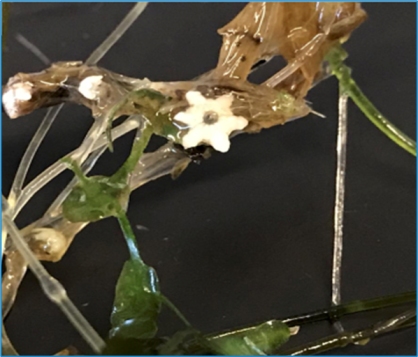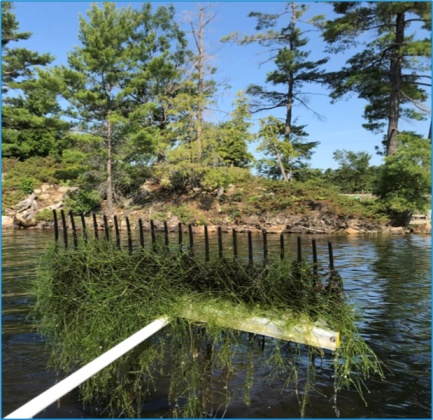In the 1970’s, a European freighter made its way across the Atlantic Ocean into the St. Lawrence River. When the ship released its ballast water, a Eurasian native macroalgae – starry stonewort (SSW), was released along with it. Quickly reproducing, the invading species flourished throughout the waters of the Great Lakes Basin by anchoring itself into waterway sediment. Having the unique ability to deposit its white bulbils (seed-like structures) into shallow sediment allowed SSW to survive Northern winters and spread with ease.

Starry stonewort resembles several Canadian native macroalgae which makes identification difficult. In addition to this, native species at risk often coexist with SSW, and management can be detrimental to our native counterparts.
The branchlets of SSW protrude from the smooth-surfaced stem in 4-6 whorled arrangements up to 80 cm in length, typically attached at an acute angle away from the nodes. Branchlets will often have odd forks and growths, resembling a wire-like structure. The pattern of these branchlets is one of the key identification features, as other macroalgae species do not replicate a wide diameter branchlet pattern that is distinctive with SSW. The bright translucent green branchlets wrap around each other like fishing lines – forming thick, dense stands where individual plants of SSW can grow up to 2 meters in height.
Small, white, star-shaped bulbils are present on clear branchlets at the base of the nodes. The bulbils – which give SSW its name, are asexual reproductive structures. These are the most identifiable feature of SSW.
The dense stands formed by SSW pose a significant threat to the biodiversity of aquatic ecosystems. The rapid growth and easy reproduction of this macroalgae creates aquatic monocultures that outcompete other desirable native species. Developed blockades of SSW can obstruct movement of fish as well as take over important spawning areas.

Starry stonewort manages to reproduce asexually through fragmentation and via bulbils. Both bulbils and fragments can root and start new populations and are responsible for SSW’s spread and establishment in new locations. For this reason, watercrafts and fishing equipment are the most likely culprits for new populations. As part of Ontario’s new updates to the Invasive Species Act, Ontario has regulated watercrafts as carriers and vectors of invasive species. Visual inspection of boats, trailers and equipment are required before moving to a new waterbody and the clean, drain, dry method is encouraged to limit the spread of invasive species. Clean your boat and gear, drain all water by opening or removing your drain plugs, and dry or disinfect your boat and equipment. Learn more about the Invasive Species Act and the Boaters Action Plan here. Know what to look for, and if you think you’ve seen starry stonewort, report the sighting immediately by visiting https://www.invasivespeciescentre.ca/report-a-sighting/ or https://www.eddmaps.org/.
